Related Research Articles

Xanthidae is a family of crabs known as gorilla crabs, mud crabs, pebble crabs or rubble crabs. Xanthid crabs are often brightly coloured and are highly poisonous, containing toxins which are not destroyed by cooking and for which no antidote is known. The toxins are similar to the tetrodotoxin and saxitoxin produced by puffer fish, and may be produced by bacteria in the genus Vibrio living in symbiosis with the crabs, mostly V. alginolyticus and V. parahaemolyticus.
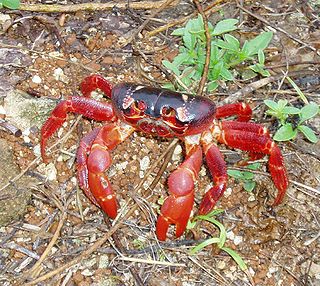
Gecarcoidea is genus of terrestrial crabs. The crabs live in forests but must come to the coast to breed. When it is dry in the summer the crabs are inactive, but when it is the wet season they are ready to migrate.

Mictyris is a genus of brightly coloured crabs, placed in its own taxonomical family, the Mictyridae. It inhabits the central Indo-West Pacific region. These crabs congregate on mud flats or beaches in groups of a few thousand, and filter sand or mud for microscopic organisms. They congregate during low tide, and bury themselves in the sand during high tide or whenever they are threatened. This is done in wet sand, and they dig in a corkscrew pattern, leaving many small round pellets of sand behind them.

Cronius is a genus of crabs containing the two species Cronius ruber and Cronius tumidulus.

Cancridae is a family of crabs. It comprises six extant genera, and ten exclusively fossil genera, in two subfamilies:

Discoplax is a genus of terrestrial crabs. It is very closely related to the genus Cardisoma.

Menippidae is a family of crabs of the order Decapoda.

Liocarcinus is a genus of crabs, which includes the flying crab, the vernal crab and several other swimming crabs.
Discoplax rotunda is a species of land crab in the genus Discoplax found in the Pacific Ocean.
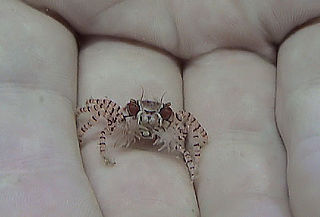
Lybia is a genus of small crabs in the family Xanthidae. Their common names include boxer crabs, boxing crabs and pom-pom crabs. They are notable for their mutualism with sea anemones, which they hold in their claws for defense. In return, the anemones get carried around, which may enable them to capture more food particles with their tentacles. Boxer crabs use at least three species of anemones, including Bundeopsis spp. and Triactis producta. The bonding with the anemone is not needed for survival, however, and boxer crabs have frequently been known to live without them, sometimes substituting other organisms such as sponges and corals for the sea anemones.

Homolodromiidae is a family of crabs, the only family in the superfamily Homolodromioidea. In contrast to other crabs, including the closely related Homolidae, there is no strong linea homolica along which the exoskeleton breaks open during ecdysis. The family comprises two genera, Dicranodromia, which has 18 species, and Homolodromia, with five species.

Matutidae is a family of crabs, sometimes called moon crabs, adapted for swimming or digging. They differ from the swimming crabs of the family Portunidae in that all five pairs of legs are flattened, rather than just the last pair, as in Portunidae. Crabs in the Matutidae are aggressive predators.
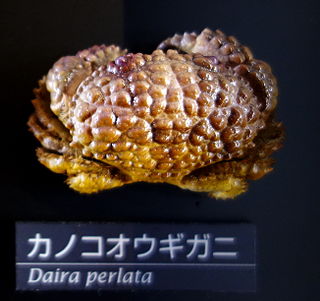
Dairoidea is a superfamily of crabs, comprising two families which each contain a single genus: Dairidae and Dacryopilumnidae (Dacryopilumnus) .
Maja capensis, the Agulhas spider crab, is a species of crab in the family Majidae.

The bathyal swimming crab, Bathynectes longispina, is a species of crab in the family Polybiidae.
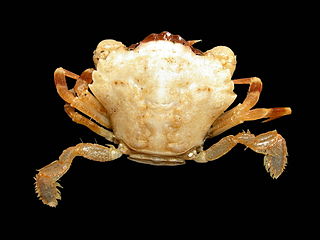
Liocarcinus pusillus, common name dwarf swimming crab, is a species of crab in the Portunidae family.

Medaeus is a genus of crabs in the family Xanthidae, containing the following species:
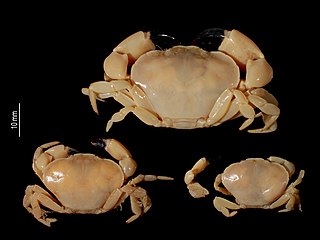
Euryxanthops is a genus of crabs in the family Xanthidae. It was originally established in 1983 by Garth & Kim to contain three species of deep-water crabs from Japan and the Philippines - Euryxanthops dorsiconvexus, Euryxanthops flexidentatus and Euryxanthops orientalis. Since then, several more species of this genus have been identified and described, and Euryxanthops currently contains:

Heikeopsis is a genus of crabs containing two species, Heikeopsis japonica and Heikeopsis arachnoides. The genus was originally described under the name "Heikea" by Lipke Holthuis and Raymond B. Manning in 1990, but was later determined to be a junior homonym of the gastropod genus Heikea, erected by Orvar Isberg in 1934.
Conleyus defodio is a species of crab, the only species in the genus Conleyus and the family Conleyidae. It lives in rubble beds in Guam, and is named after the collector Harry T. Conley.
References
- ↑ Peter Davie (2011). "Danielea noelensis (Ward, 1934)". World Register of Marine Species . Retrieved June 7, 2011.
- ↑ Peter K. L. Ng; Danièle Guinot & Peter J. F. Davie (2008). "Systema Brachyurorum: Part I. An annotated checklist of extant Brachyuran crabs of the world" (PDF). Raffles Bulletin of Zoology . 17: 1–286. Archived from the original (PDF) on 2011-06-06.